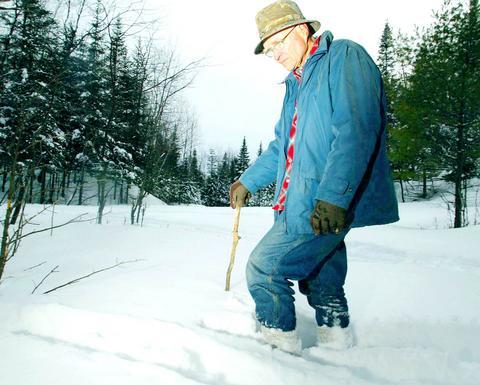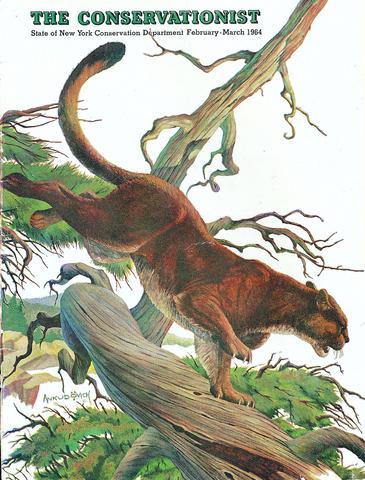Officially, the eastern cougar has not prowled the great piney woods of New York state's Adirondacks for more than 100 years. Though still listed as a federally endangered species, it is, in the minds of state environmental officials, a phantom -- extinct, kaput.
Trouble is, people keep seeing them. And one man, Peter V. O'Shea Jr., a former New York City police sergeant turned self-taught naturalist, is on a campaign to make their presence known. He himself has never seen a cougar, also called a puma, mountain lion, panther or painter. But he has talked to scores of people who say they have, and he says he has seen cougar tracks four times in the past 20 years.

PHOTO: NY TIMES
"My feeling is that in the Adirondacks, they were never quite extirpated," O'Shea said over lunch at the Lumberjack Inn here, as snow swirled outside. "Of any place they could have survived, it's here."

PHOTO: NY TIMES
At 6 million acres, the Adirondack Park is larger than the five largest national parks put together, and though it includes towns and villages tucked among its vast wilderness, in many places one can walk for miles in any direction without hitting a private dirt road.
What O'Shea finds compelling is the credible nature of many of the cougar sightings, including several by staff members of the state's Department of Environmental Conservation.
"Hate to admit it," reads one such report made to the agency in 1997 by Kenneth Kogut, its own wildlife manager for the region that covers most of the Adirondacks. "Landed in road in front of me, looked at me and in three bounds was off into shrubs on south side of road."
O'Shea believes the reason the agency does not want to admit that cougars are living in the Adirondacks has to do with time and money. Because of the cat's endangered status, official acknowledgement would likely trigger a management plan. It could also pit environmentalists against land owners already chafing under government regulation.
But state officials maintain that there is simply no sustainable, or breeding, cougar population. Yes, there are sightings, though the overwhelming majority, they say, are misidentifications. People who glimpse the real thing -- a large tawny cat weighing from 30kg to 55kg, with a black-tipped tail -- are seeing pets that either escaped or were released, officials say.
It is illegal for private citizens to keep cougars as pets in New York, but a senior wildlife biologist with the agency, Al Hicks, says people do anyway. "I'm sure a good many, after buying a cute little cougar kitten and watching it get up to 30kg, say, `Wow, I can't handle this,'" Hicks said.
In a point-counterpoint essay published in 2000 in the periodical Adirondack Explorer, Hicks and O'Shea dueled over the cougar question.
Hicks noted that only two cougars had been shot in the previous 30 years. One had clearly been a captive animal, and the other appeared to have been one as well. Furthermore, Hicks argued, there is no record of cougars taken by sportsmen before the 1970s, when it was legal to hunt them. "It would take many, many animals surviving over decades to have a population, and it's just not there," he said.
The agency receives a dozen or so reports of cougar sightings each year from across the state. But O'Shea said he knew of more than 40 sightings in just the past year in the Adirondacks and surrounding area. He does not try to argue that there is a sizable population of cougars in the park, maybe two dozen at most. And he does agree that a good number are escapes or releases.
But all of them? "I think you'd have to be blind to say there's nothing there," O'Shea said.
With tousled white hair and a preference for plaid flannel, O'Shea, 66, has become a one-man clearinghouse for cougar sightings in the Adirondacks. Some troopers even give excited callers O'Shea's name and phone number, rather than the state environmental agency's.
While some scientists may titter at O'Shea's passion for cougars, others show him respect. "He's a good naturalist," said Heidi Kretser, the program coordinator of the Wildlife Conservation Society's Adirondack Communities and Conservation Program in Saranac Lake. "He definitely has some great ideas about wildlife in the Adirondacks."
O'Shea, the author of nature and hiking guides, is a guest naturalist at the New York State Adirondack Park Agency Visitor Interpretive Center in Newcomb. He is also on the board of the Residents' Committee to Protect the Adirondacks, a nonprofit group, and the conservation chairman of the St. Lawrence Adirondack Audubon Society.
O'Shea suspects that many who see cougars do not bother to notify the state. His lunch companion, Sue Collins, a registered nurse, said she did not make a report, for instance, after she spotted one crossing Route 11 last summer outside Potsdam. "I just gasped and the person I was driving with said, `Did you see that?'" she recalled.
Hearing that, a couple at the next table, Dave and Patty McMahon, volunteer that they spotted a cougar in early 2002 bounding across Saranac Lake Road. "I've lived in this area for 50 years, and there's a distinct difference between a bobcat, a lynx and a mountain lion," said McMahon, a veteran hunter and trapper. "I saw a mountain lion."
McMahon said he did report the sighting to the Environmental Conservation agency. "They told me I was crazy," he said.
To be sure, there is nothing like a personal sighting to give even a skeptical wildlife expert pause. In the fall of 2001, while driving back from his country house in the Adirondacks, Bill Weber, director of the North America program at the Wildlife Conservation Society, which operates the Bronx Zoo, saw a cougar crossing the Taconic Parkway in Columbia County.
"It was just chewing up the road," he said in a telephone interview from Rwanda. "This wasn't just sauntering across the road like something used to hanging around people. It was remarkable."
Yet Weber is not sure what to make of the encounter. "If this truly is a relic population, and that's an interesting possibility, rest assured these were cougars who learned how to stay away from people and their vehicles," he said.
"But why aren't people finding kills?" he wondered. "Cat kills look different from other kills. There's a little bit of a Loch-Ness problem. I saw a big cat run across a highway on a Sunday afternoon. I'm certain that it was a cougar, but it doesn't tell me there's a population out there."
In the Eastern US, only the state of Florida acknowledges wild cougars, known there as Florida panthers. Despite extensive efforts to boost the population, fewer than 100 exist there today, according to federal officials.
Mountain lions are well established in most states west of the Mississippi River, and they have recently entered Iowa, Arkansas and Missouri, according to Roland Kays, the mammal curator at the New York State Museum and the co-author of, Mammals of North America (Princeton University Press, 2002).
In Kays' view, the sporadic Northeast sightings do not add up to a wild cougar presence. Kretser tends to agree. "There hasn't been a carcass or good tracks," she said. "No one has found a den per se. In places where there are cougars, these things happen."
Still, Kretser finds the continuous sightings intriguing. "There is something out there," she said. "People are definitely seeing something."
O'Shea presses on. He would like the state to acknowledge what he regards as the probability that wild cougars are here, and the possibility that they never left. "I can't prove there's a self-sustaining population," he said. "But it's beyond sense that people would be letting pets go for 50 years, and what's more that they would be surviving."

This month the government ordered a one-year block of Xiaohongshu (小紅書) or Rednote, a Chinese social media platform with more than 3 million users in Taiwan. The government pointed to widespread fraud activity on the platform, along with cybersecurity failures. Officials said that they had reached out to the company and asked it to change. However, they received no response. The pro-China parties, the Chinese Nationalist Party (KMT) and Taiwan People’s Party (TPP), immediately swung into action, denouncing the ban as an attack on free speech. This “free speech” claim was then echoed by the People’s Republic of China (PRC),

Exceptions to the rule are sometimes revealing. For a brief few years, there was an emerging ideological split between the Democratic Progressive Party (DPP) and Chinese Nationalist Party (KMT) that appeared to be pushing the DPP in a direction that would be considered more liberal, and the KMT more conservative. In the previous column, “The KMT-DPP’s bureaucrat-led developmental state” (Dec. 11, page 12), we examined how Taiwan’s democratic system developed, and how both the two main parties largely accepted a similar consensus on how Taiwan should be run domestically and did not split along the left-right lines more familiar in

Many people in Taiwan first learned about universal basic income (UBI) — the idea that the government should provide regular, no-strings-attached payments to each citizen — in 2019. While seeking the Democratic nomination for the 2020 US presidential election, Andrew Yang, a politician of Taiwanese descent, said that, if elected, he’d institute a UBI of US$1,000 per month to “get the economic boot off of people’s throats, allowing them to lift their heads up, breathe, and get excited for the future.” His campaign petered out, but the concept of UBI hasn’t gone away. Throughout the industrialized world, there are fears that

The Democratic Progressive Party (DPP) controlled Executive Yuan (often called the Cabinet) finally fired back at the opposition-controlled Legislative Yuan in their ongoing struggle for control. The opposition Chinese Nationalist Party (KMT) and Taiwan People’s Party (TPP) acted surprised and outraged, but they should have seen it coming. Taiwan is now in a full-blown constitutional crisis. There are still peaceful ways out of this conflict, but with the KMT and TPP leadership in the hands of hardliners and the DPP having lost all patience, there is an alarming chance things could spiral out of control, threatening Taiwan’s democracy. This is no